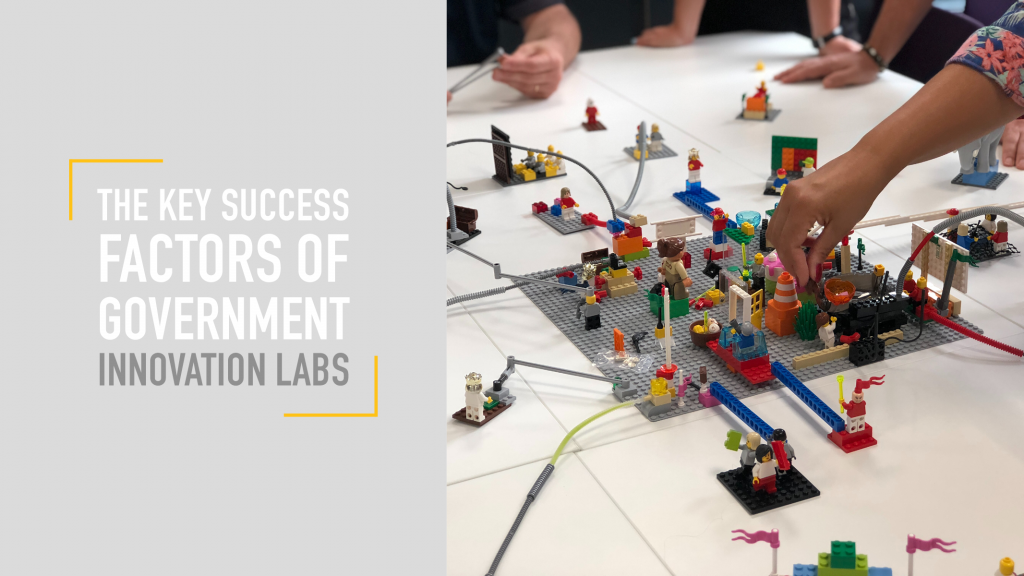Over the last years, new Government Innovation Labs have been founded all across Europe to tackle different kinds of public problems – from digitizing public services, to accelerating economic development, to transforming organisational cultures in public organisations and authorities. Government Innovation Labs (GIL) use creativity as well as systematic innovation processes and projects to find solutions to problems citizens and public administration face.
Through the Innovation in Politics Awards, as well as through Europe-wide consulting projects, we at the Innovation in Politics Institute had the opportunity to work together with different GIL all across Europe. While they all are unique, there are success factors they all share. In this article you will therefore gain insights into three success factors of Government Innovation Labs as well as get to know how selected labs in Europe incorporated them well.
Define, Measure & Communicate, Scale
In the last years we at the Institute got to know different government labs across Europe: from organizations on the municipal-level like the Torino City Lab or GovLab Arnsberg, to labs on the state-level such as InnoLab_bw in Germany, to labs on the national level such as Staatslabor in Switzerland or GovLabAustria, and even supra-national labs as the EU Policy Lab. Looking at the organizations from different angles, we argue that to successfully run a Government Innovation Lab three factors are important:
- Define its impact
- Measure and communicate its impact
- Scale its impact
Define its impact
Before a Government Innovation Lab starts its operations, it must be clear why it even exists. A clear vision about what shall be achieved is essential as this defines the organization’s processes and offers. Also, as this is especially important in hierarchical organizations as public administrations, it is essential to closely link it to internal power structures as this gives the GIL the credibility, freedom and access to necessary resources.
An interesting example is GovLab Arnsberg which helps a public administration on the regional level in Germany to find solutions to pressing challenges through interactive formats and workshops. Although the idea for this GIL came from the regional president, an interdisciplinary group from within the administration defined its tasks and envisioned impact. What is also essential is that GovLab Arnsberg is closely linked to the regional president who grants freedom to experiment and fail while protecting it from criticism.
Measure and communicate its impact
Government Innovation Labs face a tough challenge: while they need to generate quick wins to prove their legitimacy to decision-makers and employees, their innovative approaches often require iteration and failure. This is why leaders need to select an impact measurement system that shows tangible (e.g. financial) as well as intangible (e.g. new insights, new capabilities or behaviours) results. These results need to be communicated to all stakeholders to establish the GIL’s legitimacy by clearly showing its impact.
Through an iterative approach COI in Denmark developed their own impact measurement and evaluation system. The results are published annually in ‘The Innovation Barometer’. This publication builds legitimacy among decision-makers and employees as well as showcases best practice projects.
Scale its impact
Successful Government Innovation Labs (GIL) consist of a diverse team which unites experienced public servants as well as professionals with new ideas and capabilities. As our research revealed, most GIL are relatively small, with an average team size of 3-5 people. To increase their impact, successful GIL therefore shall create a support network to achieve their mission.
The Denkfabrik of the German Federal Ministry of Labour and Social Affairs explores future trends in the job market and contributes to new policies. This GIL is set within the structures of the Ministry but its team includes people from inside and outside the public administration. This helps to be close to the established policy-making process while ensuring that a variety of other perspectives is included in its work.
In this blog you deep dived into three key success factors of Government Innovation Labs from an outside perspective. In the next piece an expert in the field, Alexander Grünwald from the GovLabAustria, will provide you with his reflections on these three success factors from an insider’s perspective. Stay tuned!
Marie Wutzler is Project manager at the Innovation in Politics Institute with a focus on public innovation. Marie holds a Design Thinking education from the renowned Hasso Plattner Institute and is co-initiator of ToolFest Berlin, an innovation academy for innovators in the political, public and private sphere.
Nicolas Stühlinger is Senior Advisor at the Innovation in Politics Institute. In this position he co-creates long-term programs with a positive impact on politics and society, like training and networking opportunities for political professionals, and platforms for democratic practice exchange.
